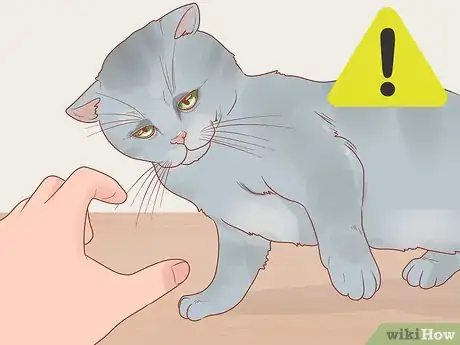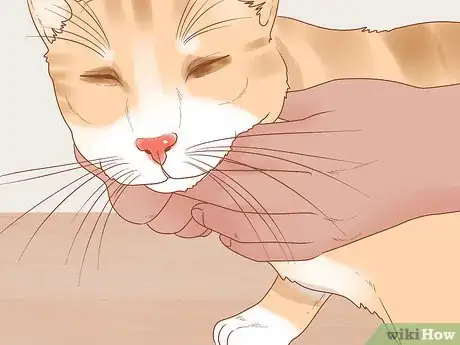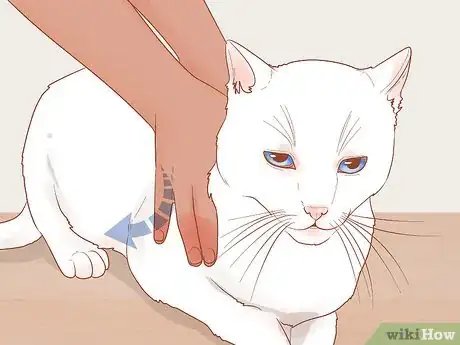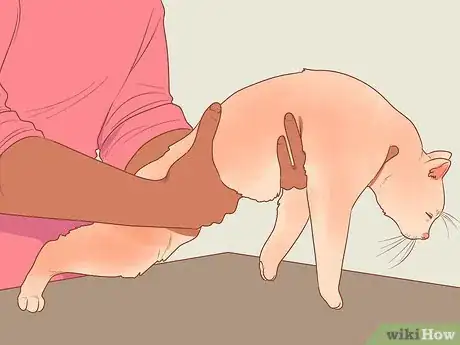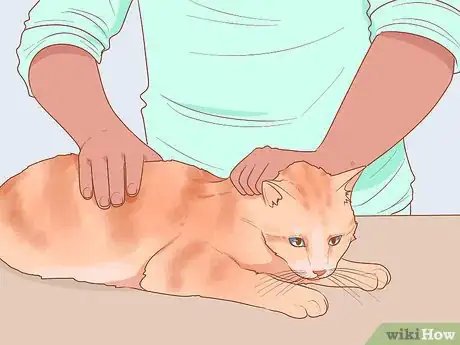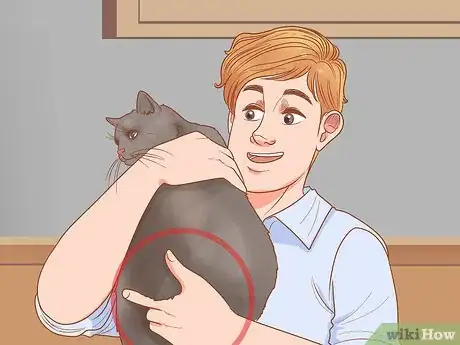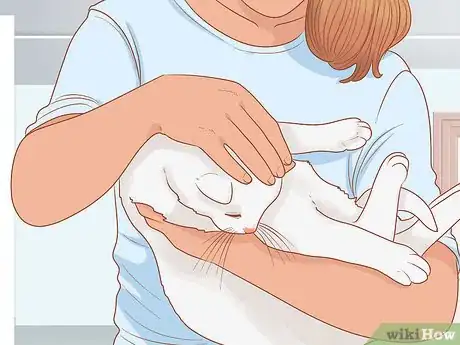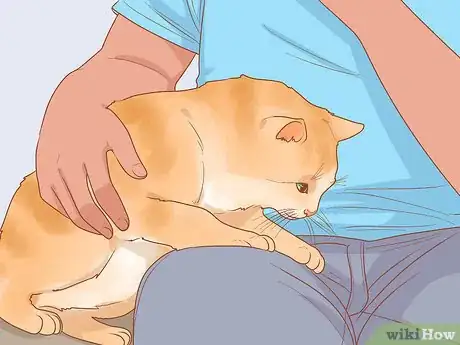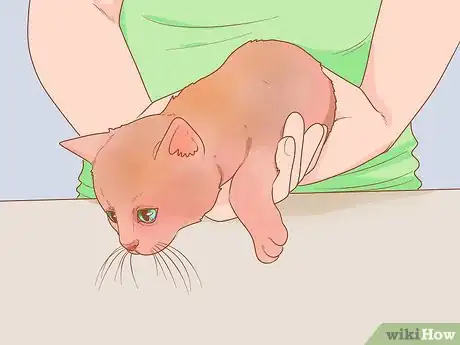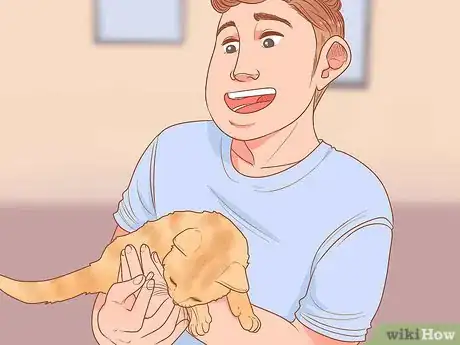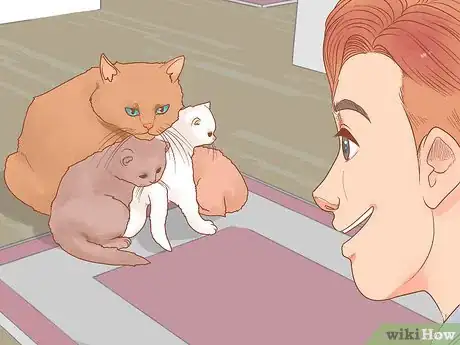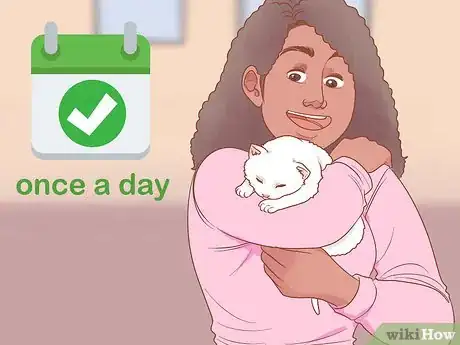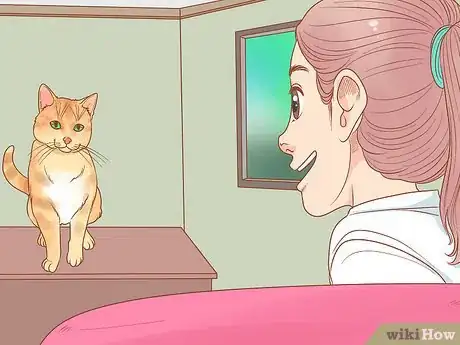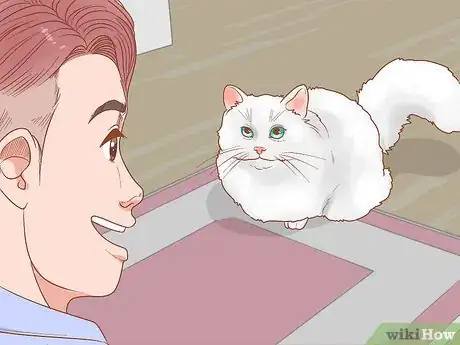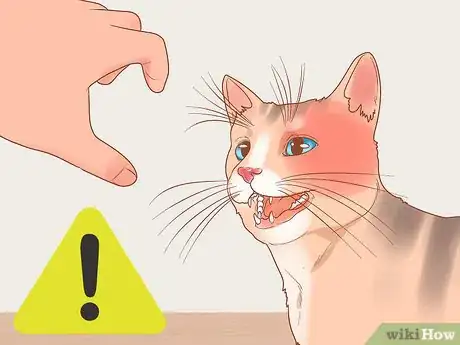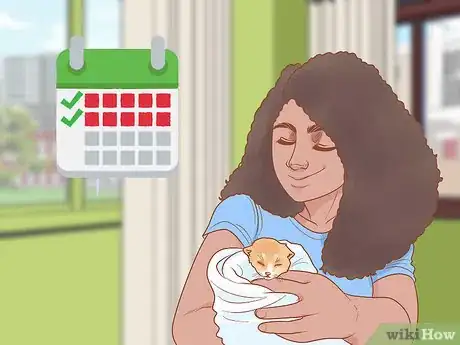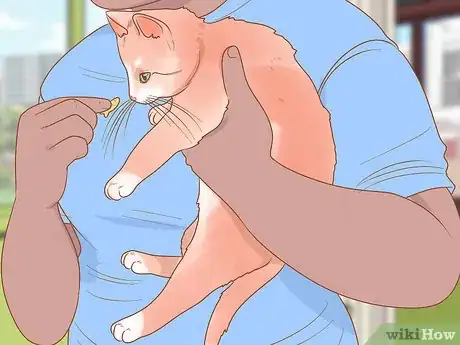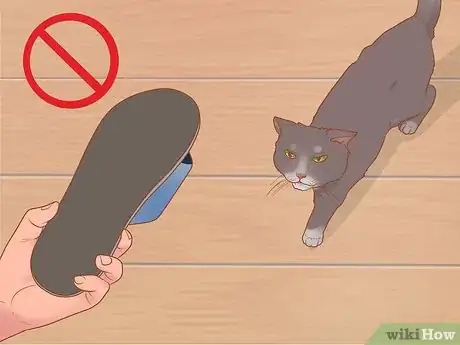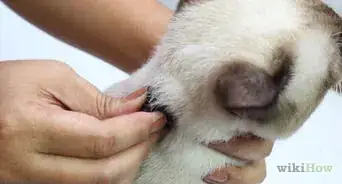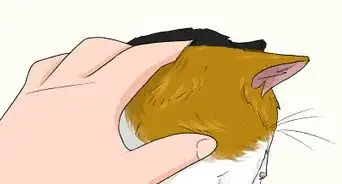This article was co-authored by Brian Bourquin, DVM. Brian Bourquin, better known as “Dr. B” to his clients, is a Veterinarian and the Owner of Boston Veterinary Clinic, a pet health care and veterinary clinic with three locations, South End/Bay Village, the Seaport, and Brookline, Massachusetts. Boston Veterinary Clinic specializes in primary veterinary care, including wellness and preventative care, sick and emergency care, soft-tissue surgery, dentistry. The clinic also provides specialty services in behavior, nutrition, and alternative pain management therapies using acupuncture, and therapeutic laser treatments. Boston Veterinary Clinic is an AAHA (American Animal Hospital Association) accredited hospital and Boston’s first Fear Free Certified Clinic. Brian has over 19 years of veterinary experience and earned his Doctor of Veterinary Medicine from Cornell University.
There are 15 references cited in this article, which can be found at the bottom of the page.
wikiHow marks an article as reader-approved once it receives enough positive feedback. This article received 13 testimonials and 87% of readers who voted found it helpful, earning it our reader-approved status.
This article has been viewed 270,900 times.
With their cute faces and soft fur, cats can be wonderful creatures to hold. But cats are also known for their fickle personalities: they can also be easily frightened around strangers and even ambivalent about affection from those they know well. To avoid frustrating, scaring, or hurting a cat, it is important to pick it up and hold it correctly.
Steps
Picking a Cat Up
-
1Know if your cat wants to be picked up. Sometimes, cats just don’t want to be picked up. It’s important to be able to read your cat’s mood.[1] If your cat seems angry or scared, you risk being scratched if you try to pick him up. With this in mind, there are some ways you can read your cat’s mood.
- Look at your cat's overall body language. Is he hiding from you or not coming out to play? Just like adults, cats need alone time, and if he is hiding it is a good indication he does not want your attention at the moment. Is he actively seeking attention, meowing, purring, or rubbing against your legs? These all indicate that he is interested in socialization. Rubbing against you in particular indicates he is trying to leave his scent on you, which is an affectionate feline bonding habit and indicates he is open to affection from you in return.
- Unlike dogs, cats’ tails don’t wag when they’re happy. A slow back and forth tail movement usually means your cat is assessing a situation. If your cat’s tail is wagging, it’s not a good time to attempt to hold your cat.[2]
- Look at your cat’s ears. Ears that are facing forward means your cat is feeling playful and content; this is a good time to pick him up. If your cat’s ears are facing backwards, watch out! Backwards-facing or flat ears indicate it's not a good time to attempt to hold your cat.[3]
-
2Crouch down to your cat’s level. When you begin to pick up a cat, it can frighten him if you are towering above him.
- Crouching down to his level allows you to reassure your cat before you attempt to pick him up. It also gives him the chance to rub against your torso, which deposits his scent pheromones on your clothing and body and helps him feel more comfortable when you hold him.
Advertisement -
3Place your dominant hand under your cat's torso. It should be positioned directly behind his front legs. You will feel his firm rib cage under your fingers when your hand is in the right place, not his soft belly.
- Use your free hand to support your cat's bottom and back legs. Place it under his hind feet so that your hand is above and behind his paws.[4]
-
4Lift your cat. Once your hands are in the right place, you can lift your cat up so that you are standing up straight. The hand and forearm under your cat’s hind legs should make a platform to support your cat.
- Pull the cat against your chest to provide more support and to help him feel more secure.[5]
-
5Reserve scruffing for emergency situations. Cats have extra skin on the back of their neck (called the "scruff"), which mother cats use to easily carry their kittens from place to place. However, an adult cat's body is quite heavy and it puts too much strain on the scruff to carry a cat this way routinely.[6]
- If it is an emergency and your cat is scared, you can pick him up by the scruff, but be careful to support his body weight with your hand under his rump, using a towel to wrap the cat's body if it is struggling.[7]
- Only scruff a cat if you need to move it quickly (for instance, if the house is on fire and you need to exit to safety). In these types of instances when a cat is highly agitated, scruffing a cat can prevent you from being scratched.[8]
- You can also hold a cat by the scruff if you need to administer medication without the cat struggling, or if you have to handle a feral cat.[9]
Holding Your Cat and Putting Him Down
-
1Support your cat while holding him. It’s important to hold a cat so that you're supporting his weight.[10] Lay your arm against your torso so that it forms a platform for your cat to rest on. You can support his rump in the crook of your elbow so that his front paws rest of your hand.
- When your cat is comfortable being held, you can try holding him in different ways--it really depends on your cat's personality. Some cats like to be held against your chest with paws up on your shoulder so they can see over your shoulder as you walk; others like to lay on their backs with their stomachs up like human babies.[11]
-
2Pet your cat while holding him. When you hold your cat along the length of one arm, your other hand is free to stroke and pet him. Just be careful to keep supporting his body and legs.
- Petting your cat will soothe him and make him feel more comfortable in your arms. It’s also good to talk to your cat in a calm tone. This way, he will feel at ease and may even doze.
-
3Hold your cat while sitting. If you want to hold your cat on your lap while watching TV, let your cat figure out where he wants to sit. Chances are, he will settle on your lap, either in the indent between your legs, or curled up on your lap.
- Be sure you instruct the child to let go of the cat immediately if it struggles or acts as if it would like down. Otherwise, the child may end up being scratched.[12]
-
4Put your cat back down. When you (or your cat) are done hanging out, put him down gently and safely.
- Bend down so that your cat’s paws touch or are close to the ground. Put his front paws on the ground and support his hind end as he steps out of your arms, and release your hands gently.[13] Your cat will do most of the work by jumping out of your hands.
Holding a Small Kitten
-
1Start early. Socialization of cats happens by the time they are 12 weeks old, and after that age it will be harder to train a cat to enjoy being held.
- This makes the early weeks of a cat's life the ideal time to teach it to enjoy being held by humans.[14]
- Avoid over-handling kittens in the first week of life, as doing so might upset their mother and potentially cause her to reject them.[15] However, if the mom does not mind your presence or seems to actively encourage you to notice her kittens, you can briefly hold or pet even newborn kittens a few times a day. Doing so has been shown to help kittens open their eyes earlier and begin exploring earlier.[16]
- When the kittens are very young (two weeks or so), a few minutes a day is plenty of stimulation. Gently pick up the kittens one at a time supporting their chests and legs. Hold them carefully in both hands, and place them back down in the same place.
-
2Watch the mother cat's cues handling her kittens. Cats can be very protective, depending on their personalities, and you do not want to cause her any undue stress or cause her to view you as a threat to her babies.
- If she seems overly protective, it is still important that you handle the kittens in the early days so that they become properly socialized to humans. Just try to time your interaction with the kittens for when she is out of the room (for instance, while she eats or uses the bathroom) in order to reduce her anxiety.[17]
-
3Hold your kitten at least once a day. This helps form a habit and associates holding with bonding time and affection.[18]
- Aim for five minutes or so, and keep the time together peaceful and gentle.
- Don't encourage rough play or allow the kitten to use your hands as toys by biting or scratching. This can create a bad habit by associating your hands with toys instead of petting and holding, creating a feisty cat that can be harder to play with as it grows into an adult.[19]
Approaching a Strange Cat
-
1Take your time. Just like humans, most cats are nervous around strangers and take time to get comfortable with someone new. Respect their comfort by letting them get to know you a bit before you attempt to touch or hold them. Taking your time before touching or holding a strange cat also gives you time to assess the cat's personality and whether or not it is safe to continue.
- If you don't know a cat, consider it a wild animal. Since you have no way of knowing if a cat is friendly or not, or even whether it has a transmittable disease, it's best to err on the side of caution until you have reason to believe otherwise.[20]
- If a cat's owner is nearby, ask whether the cat likes to be touched or held before attempting this. Remember, a cat is its owner's property, so you must respect the owner's wishes even if they refuse to let you touch a perfectly friendly cat.[21]
-
2Move slowly. Sudden movements will frighten even a friendly cat, so be sure to slowly crouch down and speak in soothing tones.
- Avoid direct eye contact (which cats see as a threat)[22] , and slowly extend your hand toward the cat. Allow the cat to come to you, sniffing your hand for reassurance.
-
3Avoid picking him up unless you need to. Particularly if the owner is not present, it's not a good idea to attempt to restrain or hold a cat you don't know well. It can be stressful for the cat and dangerous for you.
- Keep in mind that you might be scratched or bitten; not only can scratches and bite marks hurt but a strange cat may have any number of communicable diseases (such as infection at the site of the bite or scratch, cat scratch fever, or rabies).[23] it.
- In situations where you must handle a strange cat for its own safety (for example, to remove it from harm's way), you can try holding the cat by the scruff of its neck. Gently but firmly squeeze the extra skin just under the base of the cat's skull. Be careful to support his body weight with your hand under his rump, using a towel to wrap the cat's body if it is struggling.[24]
Training a Cat to Like Being Held
-
1Start early. Cats are socialized by the time they are 12 weeks old, which means that beyond that age it is harder to train a cat to enjoy being held.
- Cats who were not handled much as kittens (for example, those raised feral or in kitten mills) are less likely to enjoy being held as adults. This makes the early weeks of a cat's life the idea time to teach it to enjoy being held by humans.[25]
-
2Use positive reinforcement. Although some cats do not like being held because of their personalities, most can be trained to accept it if they know they will receive a reward.
- Train your cat to remain calm and hold still to be lifted by saying the word "hold" and laying your hand on the cat's side. If the cat remains still, say "good" and reward with a small cat treat or a scratch on the head or chin.[26]
- When the cat is comfortable with holding still, add another hand to the cats side when you say "hold", gently cupping your hands under the cat's stomach to simulate holding but leaving her feet on the ground. Again, if the cat remains still, say "good" and reward with a treat.[27]
- Finally, add an actual lift when you say the word "hold," and if the cat does not struggle when you lift her, say "good" and reward her while you hold her securely to your chest.[28]
- Reinforce this new skill a few times a day for several days. After that, try reinforcing the behavior through means other than treats, such as head scratching.
-
3Avoid punishment. Cats respond poorly to punishment, which usually backfires and results in an even more skittish cat.
- Punishing a cat will only cause it to run and hide, making it even more difficult to hold. In addition, punishing a cat increases its stress response, which can cause feline illness, incontinence, and compulsive grooming.[29]
- Instead, train your cat using positive reinforcement, patience, and his favorite cat treat.
Expert Q&A
-
QuestionHow do cats like to be held?
 Brian Bourquin, DVMBrian Bourquin, better known as “Dr. B” to his clients, is a Veterinarian and the Owner of Boston Veterinary Clinic, a pet health care and veterinary clinic with three locations, South End/Bay Village, the Seaport, and Brookline, Massachusetts. Boston Veterinary Clinic specializes in primary veterinary care, including wellness and preventative care, sick and emergency care, soft-tissue surgery, dentistry. The clinic also provides specialty services in behavior, nutrition, and alternative pain management therapies using acupuncture, and therapeutic laser treatments. Boston Veterinary Clinic is an AAHA (American Animal Hospital Association) accredited hospital and Boston’s first Fear Free Certified Clinic. Brian has over 19 years of veterinary experience and earned his Doctor of Veterinary Medicine from Cornell University.
Brian Bourquin, DVMBrian Bourquin, better known as “Dr. B” to his clients, is a Veterinarian and the Owner of Boston Veterinary Clinic, a pet health care and veterinary clinic with three locations, South End/Bay Village, the Seaport, and Brookline, Massachusetts. Boston Veterinary Clinic specializes in primary veterinary care, including wellness and preventative care, sick and emergency care, soft-tissue surgery, dentistry. The clinic also provides specialty services in behavior, nutrition, and alternative pain management therapies using acupuncture, and therapeutic laser treatments. Boston Veterinary Clinic is an AAHA (American Animal Hospital Association) accredited hospital and Boston’s first Fear Free Certified Clinic. Brian has over 19 years of veterinary experience and earned his Doctor of Veterinary Medicine from Cornell University.
Veterinarian Every cat is different, and some cats don't like to be held at all. The most important thing is to know your cat. When you do hold your cat, make sure you're supporting its weight. Don't hold it under its front legs or scruff its neck.
Every cat is different, and some cats don't like to be held at all. The most important thing is to know your cat. When you do hold your cat, make sure you're supporting its weight. Don't hold it under its front legs or scruff its neck. -
QuestionIs it bad to hold your cat?
 Brian Bourquin, DVMBrian Bourquin, better known as “Dr. B” to his clients, is a Veterinarian and the Owner of Boston Veterinary Clinic, a pet health care and veterinary clinic with three locations, South End/Bay Village, the Seaport, and Brookline, Massachusetts. Boston Veterinary Clinic specializes in primary veterinary care, including wellness and preventative care, sick and emergency care, soft-tissue surgery, dentistry. The clinic also provides specialty services in behavior, nutrition, and alternative pain management therapies using acupuncture, and therapeutic laser treatments. Boston Veterinary Clinic is an AAHA (American Animal Hospital Association) accredited hospital and Boston’s first Fear Free Certified Clinic. Brian has over 19 years of veterinary experience and earned his Doctor of Veterinary Medicine from Cornell University.
Brian Bourquin, DVMBrian Bourquin, better known as “Dr. B” to his clients, is a Veterinarian and the Owner of Boston Veterinary Clinic, a pet health care and veterinary clinic with three locations, South End/Bay Village, the Seaport, and Brookline, Massachusetts. Boston Veterinary Clinic specializes in primary veterinary care, including wellness and preventative care, sick and emergency care, soft-tissue surgery, dentistry. The clinic also provides specialty services in behavior, nutrition, and alternative pain management therapies using acupuncture, and therapeutic laser treatments. Boston Veterinary Clinic is an AAHA (American Animal Hospital Association) accredited hospital and Boston’s first Fear Free Certified Clinic. Brian has over 19 years of veterinary experience and earned his Doctor of Veterinary Medicine from Cornell University.
Veterinarian Only if your cat doesn't want to be held. Watch for signs of anxiety, like a thumping or wagging tail and flat ears. If your cat shows any of these signs, he doesn't want to be picked up!
Only if your cat doesn't want to be held. Watch for signs of anxiety, like a thumping or wagging tail and flat ears. If your cat shows any of these signs, he doesn't want to be picked up! -
QuestionCan a kid hold my cat?
 Brian Bourquin, DVMBrian Bourquin, better known as “Dr. B” to his clients, is a Veterinarian and the Owner of Boston Veterinary Clinic, a pet health care and veterinary clinic with three locations, South End/Bay Village, the Seaport, and Brookline, Massachusetts. Boston Veterinary Clinic specializes in primary veterinary care, including wellness and preventative care, sick and emergency care, soft-tissue surgery, dentistry. The clinic also provides specialty services in behavior, nutrition, and alternative pain management therapies using acupuncture, and therapeutic laser treatments. Boston Veterinary Clinic is an AAHA (American Animal Hospital Association) accredited hospital and Boston’s first Fear Free Certified Clinic. Brian has over 19 years of veterinary experience and earned his Doctor of Veterinary Medicine from Cornell University.
Brian Bourquin, DVMBrian Bourquin, better known as “Dr. B” to his clients, is a Veterinarian and the Owner of Boston Veterinary Clinic, a pet health care and veterinary clinic with three locations, South End/Bay Village, the Seaport, and Brookline, Massachusetts. Boston Veterinary Clinic specializes in primary veterinary care, including wellness and preventative care, sick and emergency care, soft-tissue surgery, dentistry. The clinic also provides specialty services in behavior, nutrition, and alternative pain management therapies using acupuncture, and therapeutic laser treatments. Boston Veterinary Clinic is an AAHA (American Animal Hospital Association) accredited hospital and Boston’s first Fear Free Certified Clinic. Brian has over 19 years of veterinary experience and earned his Doctor of Veterinary Medicine from Cornell University.
Veterinarian It's better to have the child sit on a chair or sofa, or even the ground, and then place the cat on their lap for them to pet.
It's better to have the child sit on a chair or sofa, or even the ground, and then place the cat on their lap for them to pet.
Warnings
- Holding a cat incorrectly can cause injuries to its bones or internal organs, so be sure to supervise small children when they hold a cat.⧼thumbs_response⧽
- If your cat gets startled or agitated while you are holding him, put him down immediately or he may scratch or bite you.⧼thumbs_response⧽
- If you are scratched or bit by a cat, seek medical attention. You may need a vaccine or medication to prevent infection or disease.⧼thumbs_response⧽
References
- ↑ Brian Bourquin, DVM. Veterinarian. Expert Interview. 20 December 2019.
- ↑ http://www.petfinder.com/cats/bringing-a-cat-home/how-to-read-cats-body-language/
- ↑ http://www.petfinder.com/cats/bringing-a-cat-home/how-to-read-cats-body-language/
- ↑ http://www.catster.com/cat-behavior/how-to-handle-a-cat
- ↑ http://www.vetstreet.com/dr-marty-becker/scruffing-no-way-to-lift-an-adult-cat
- ↑ http://www.petmeds.org/petmeds-spotlight/is-it-okay-to-scruff-my-cat/#.VfxbfJdqa2E
- ↑ http://www.petmeds.org/petmeds-spotlight/is-it-okay-to-scruff-my-cat/#.VfxbfJdqa2E
- ↑ http://www.petmeds.org/petmeds-spotlight/is-it-okay-to-scruff-my-cat/#.VfxbfJdqa2E
- ↑ http://www.petmeds.org/petmeds-spotlight/is-it-okay-to-scruff-my-cat/#.VfxbfJdqa2E
- ↑ Brian Bourquin, DVM. Veterinarian. Expert Interview. 20 December 2019.
- ↑ http://www.catster.com/cat-behavior/how-to-handle-a-cat
- ↑ http://www.vetstreet.com/dr-marty-becker/can-i-teach-my-cat-to-let-kids-hold-him
- ↑ http://www.vetstreet.com/dr-marty-becker/scruffing-no-way-to-lift-an-adult-cat
- ↑ https://www.aspca.org/pet-care/virtual-pet-behaviorist/cat-behavior/socializing-your-kitten
- ↑ https://www.aspca.org/pet-care/cat-care/newborn-kitten-care
- ↑ https://www.aspca.org/pet-care/virtual-pet-behaviorist/cat-behavior/socializing-your-kitten
- ↑ https://www.aspca.org/pet-care/virtual-pet-behaviorist/cat-behavior/socializing-your-kitten
- ↑ http://www.kittenbaby.com/socializing.php
- ↑ http://www.kittenbaby.com/socializing.php
- ↑ https://books.google.com/books/about/Outsmarting_Cats.html?id=aA64MQEACAAJ
- ↑ https://books.google.com/books/about/Outsmarting_Cats.html?id=aA64MQEACAAJ
- ↑ https://www.aspca.org/pet-care/virtual-pet-behaviorist/cat-behavior/stray-and-feral-cats
- ↑ https://www.minnpost.com/second-opinion/2014/02/cat-bites-hand-can-cause-serious-infections-mayo-study-finds
- ↑ http://www.petmeds.org/petmeds-spotlight/is-it-okay-to-scruff-my-cat/#.VfxbfJdqa2E
- ↑ https://www.aspca.org/pet-care/virtual-pet-behaviorist/cat-behavior/socializing-your-kitten
- ↑ http://www.vetstreet.com/our-pet-experts/5-keys-to-picking-up-and-holding-your-cat-the-right-way
- ↑ http://www.vetstreet.com/our-pet-experts/5-keys-to-picking-up-and-holding-your-cat-the-right-way
- ↑ http://www.vetstreet.com/our-pet-experts/5-keys-to-picking-up-and-holding-your-cat-the-right-way
- ↑ https://www.aspca.org/pet-care/virtual-pet-behaviorist/cat-behavior/training-your-cat
About This Article
To hold a cat, crouch down to its level and put your dominant hand under its ribcage. Use your other hand to support the cat’s bottom and back legs, and pick up the cat so your non-dominant hand becomes a support for it to sit on. Then, make the cat feel more secure by hugging it to your chest. In an emergency, pick up a cat by grabbing the scruff, or extra skin, on the back of its neck while supporting its bottom with your other hand. To learn more from our reviewer about holding cats, including how to know when to pick it up, keep reading!
